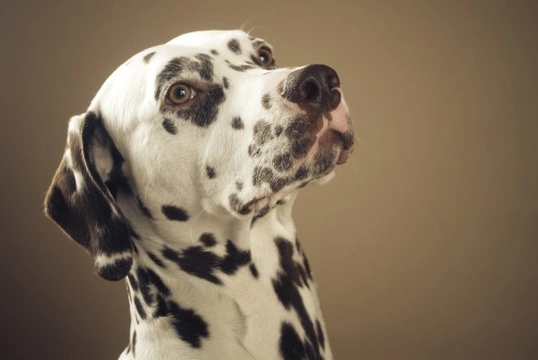
Dalmatian deafness and colour genetics
The Dalmatian is an instantly recognisable breed of dog, due to their distinctive spotted coats and outgoing personalities! Undeniably appealing thanks to both their sunny disposition and attractive appearance, the Dalmatian is a popular choice of pedigree dog for many people, and one that is totally at home among families with children. They are generally considered to be a hardy, healthy breed that often live to a relatively old age, and are not prone to a particularly wide range of genetic and inherited health problems. However, the Dalmatian does have a genetic predisposition to deafness and other hearing impairments, and many dogs of the breed will be affected by hearing difficulties to some extent.
Read on to learn more about Dalmatians and deafness, plus the role that the genetics of the Dalmatian’s coat colour plays in this.
Dalmatian health and lifespan
The Dalmatian has an average lifespan of 11-13 years, although it is not uncommon for Dalmatians to live well into their late teens. Dalmatians do have elevated risk factors for a range of health conditions that are considered to be breed-specific and herediatary, including:
- Deafness
- Urinary stones
- Allergies
- Hip dysplasia
- Arthritis
The condition most commonly associated with Dalmatians and the one that presents itself more commonly than any other issue, however, is deafness.
The Dalmatian coat and colour
While everyone is familiar with the spotted appearance of the Dalmatian coat, Dalmatian puppies are actually born pure white, and only begin to develop their spots at around three weeks of age.
Most of the spots will be present by the time the pups have reached four weeks of age, although these dogs will continue to develop spots at a much slower rate throughout the duration of their lives. Dalmatians can commonly be seen with black or liver-coloured spots on a white coat, although other rarer colour variations such as blue, brindle, orange and lemon may also be seen as well. Spots or patches of spots cover the entire body, and are usually densest around the ears and the head.
The Dalmatian has a short, fine coat that is stiff and wiry, and relatively easy to keep groomed. Dalmatians shed hair year-round, although their skin is not particularly oily and they are usually regarded as one of the less “smelly” breeds of dog!
Dalmatian deafness and hearing issues
The Dalmatian has a pronounced genetic predisposition to deafness, with around 30% of dogs of the breed being affected by deafness or hearing impairment to some extent.
Deafness is often associated with coat colour, and it is now known that the genes that provide a piebald (spotted colour on white) or albino coat can also cause deafness, due to a lack of mature melanocytes (melanin producing cells) within the inner ear. This issue can affect either one ear or both ears, and will not necessarily present itself in all dogs with a piebald or albino coat.
Blue eyes in the Dalmatian are also associated with an increased likelihood of deafness, and Dalmatians that have blue eyes rather than brown are exponentially more likely to be deaf, although it is not yet known why this is. While blue eyed Dalmatians will by no means always be deaf, blue eyes in the dog is considered by many breed authorities to be a fault, and the breeding of blue eyed dogs is sometimes discouraged.
It has been found that Dalmatians whose coats are more patched than spotted, such as when the spots are so close together as to form large patches of darker pigment, the occurrence rate of deafness is much lower. While breeding for a patched coat rather than a spotted coat might ultimately help to reduce the occurrence rate of deafness across the breed as a whole, this is currently discouraged. The breed standard coat pattern for the Dalmatian consists of spots rather than patches, a trait that breeders and breed authorities are keen to preserve.
Deafness in both ears of the Dalmatian is known as bilateral deafness, while deafness in one ear only is called unilateral. Being able to hear effectively with both ears is known as bilateral hearing, and only Dalmatians who have bilateral hearing should be used for breeding. Many Dalmatian breeders will undertake hearing tests on the pups that they produce prior to sale, in order to verify the hearing ability of the dog in question.
While deaf or partially deaf Dalmatians should not be used for breeding (as they are exponentially more likely to produce deaf puppies) there is no reason whatsoever why deaf Dalmatians or any other deaf dogs would not make great pets.
Many deaf and hard of hearing dogs lead full, happy lives, and can be trained and cared for and kept safe by the conscientious owner. Training and living with a deaf dog does need to be approached rather differently than training a hearing dog, but there are plenty of alternatives to get your dog’s attention than the usual vocal commands that most of us use.
For more information on training and managing a deaf dog, check out our previous articles on training a deaf dog and living with a deaf dog.



